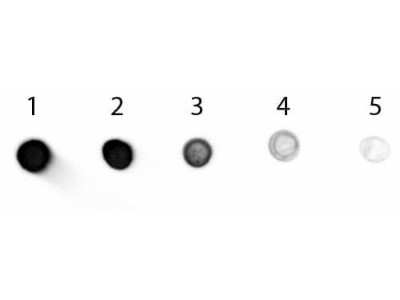Donkey anti-Goat IgG (H+L) Secondary Antibody [Alkaline Phosphatase]
Novus Biologicals, part of Bio-Techne | Catalog # NBP1-72568


Conjugate
Catalog #
Key Product Details
Species Reactivity
Goat
Applications
Dot Blot, ELISA, Immunocytochemistry/ Immunofluorescence, Immunohistochemistry, Immunohistochemistry-Paraffin, Western Blot
Label
Alkaline Phosphatase
Antibody Source
Polyclonal Donkey IgG
Concentration
Please see the vial label for concentration. If unlisted please contact technical services.
Product Specifications
Immunogen
Donkey anti-Goat IgG (H+L) Secondary Antibody [Alkaline Phosphatase] was produced by repeated immunization with goat IgG whole molecule in donkey.
Clonality
Polyclonal
Host
Donkey
Isotype
IgG
Description
Store vial at 4C before opening. DO NOT FREEZE. This product is stable at 4C as an undiluted liquid. Dilute only prior to immediate use. Freezing alkaline phosphatase conjugates will result in a substantial loss of enzymatic activity.
This product was prepared from monospecific antiserum by immunoaffinity chromatography using Goat IgG coupled to agarose beads followed by solid phase adsorption(s) to remove any unwanted reactivities. Assay by immunoelectrophoresis resulted in a single precipitin arc against anti-Alkaline Phosphatase (calf intestine), anti-Donkey Serum, Goat IgG and Goat Serum.
This product was prepared from monospecific antiserum by immunoaffinity chromatography using Goat IgG coupled to agarose beads followed by solid phase adsorption(s) to remove any unwanted reactivities. Assay by immunoelectrophoresis resulted in a single precipitin arc against anti-Alkaline Phosphatase (calf intestine), anti-Donkey Serum, Goat IgG and Goat Serum.
Scientific Data Images for Donkey anti-Goat IgG (H+L) Secondary Antibody [Alkaline Phosphatase]
Dot Blot: Donkey anti-Goat IgG (H+L) Secondary Antibody [Alkaline Phosphatase] [NBP1-72568]
Donkey anti-Goat IgG (H+L) Secondary Antibody [Alkaline Phosphatase]
Dot Blot of Donkey anti-Donkey anti-Goat IgG (H+L) Secondary Antibody [Alkaline Phosphatase]. Antigen: Goat IgG. Load: Lane 1 - 200 ng Lane 2 - 66.7 ng Lane 3 - 22.2 ng Lane 4 - 7.41 ng Lane 5 - 2.47 ng. Primary antibody: n/a. Secondary antibody: Donkey anti-Donkey anti-Goat IgG (H+L) Secondary Antibody [Alkaline Phosphatase] at 1:1,000 for 60 min at RT. Block for 1 HR at RT.Applications for Donkey anti-Goat IgG (H+L) Secondary Antibody [Alkaline Phosphatase]
Application
Recommended Usage
ELISA
1:2000 - 1:10000
Immunocytochemistry/ Immunofluorescence
0.25-2 ug/ml
Immunohistochemistry
1:200 - 1:1000
Immunohistochemistry-Paraffin
1:50-1:200
Western Blot
1:500 - 1:2500
Application Notes
This product has been tested by ELISA and dot blot and is suitable for immunoblotting (western or dot blot), ELISA, immunoelectron microscopy and immunohistochemistry as well as other antibody-based enzymatic assays requiring lot-to-lot consistency.
Formulation, Preparation, and Storage
Purification
Multi-step
Formulation
0.05 M Tris Chloride, 0.15M Sodium Chloride, 0.001M Magnesium Chloride, 0.0001M Zinc Chloride, 50% (v/v) Glycerol; pH 8.0, 10 mg/mL Bovine Serum Albumin (BSA) - Immunoglobulin and Protease free
Preservative
0.1% Sodium Azide
Concentration
Please see the vial label for concentration. If unlisted please contact technical services.
Shipping
The product is shipped with polar packs. Upon receipt, store it immediately at the temperature recommended below.
Stability & Storage
Store at 4C. Do not freeze.
Background: IgG (H+L)
The 4 IgG subclasses, sharing 95% amino acid identity, include IgG1, IgG2, IgG3, and IgG4 for humans and IgG1, IgG2a, IgG2b, and IgG3 for mice. The relative abundance of each human subclass is 60% for IgG1, 32% for IgG2, 4% for IgG3, and 4% for IgG4. In an IgG deficiency, there may be a shortage of one or more subclasses (4).
References
1. Painter RH. (1998) Encyclopedia of Immunology (Second Edition). Elsevier. 1208-1211
2. Chapter 9 - Antibodies. (2012) Immunology for Pharmacy. Mosby 70-78
3. Schroeder H, Cavacini, L. (2010) Structure and Function of Immunoglobulins. J Allergy Clin Immunol. 125(2 0 2): S41-S52. PMID: 20176268
4. Vidarsson G, Dekkers G, Rispens T. (2014) IgG subclasses and allotypes: from structure to effector functions. Front Immunol. 5:520. PMID: 25368619
Additional IgG (H+L) Products
Product Documents for Donkey anti-Goat IgG (H+L) Secondary Antibody [Alkaline Phosphatase]
Product Specific Notices for Donkey anti-Goat IgG (H+L) Secondary Antibody [Alkaline Phosphatase]
This product is for research use only and is not approved for use in humans or in clinical diagnosis. Secondary Antibodies are guaranteed for 1 year from date of receipt.
Loading...
Loading...
Loading...
Loading...
![Donkey anti-Goat IgG (H+L) Secondary Antibody [Alkaline Phosphatase] Donkey anti-Goat IgG (H+L) Secondary Antibody [Alkaline Phosphatase]](https://resources.bio-techne.com/images/products/nbp1-72568_donkey-polyclonal-donkey-anti-goat-igg-h-l-secondary-antibody-alkaline-phosphatase-23520231753185.jpg)